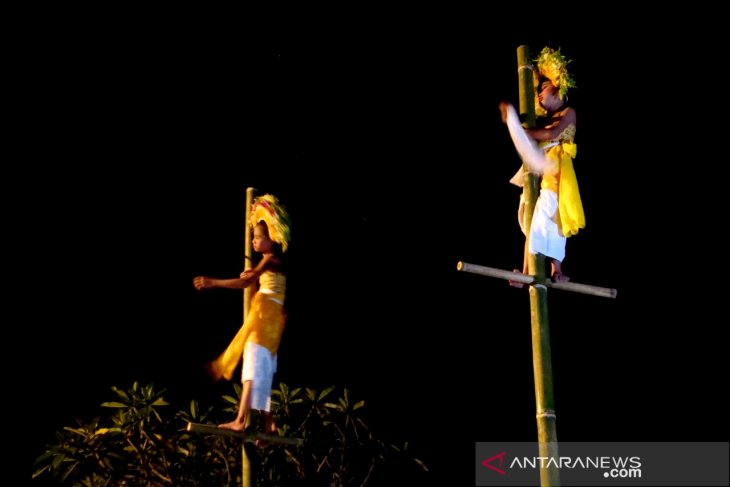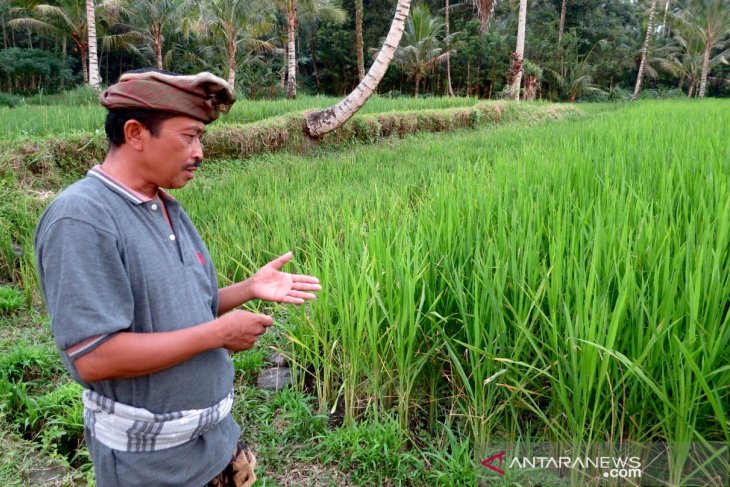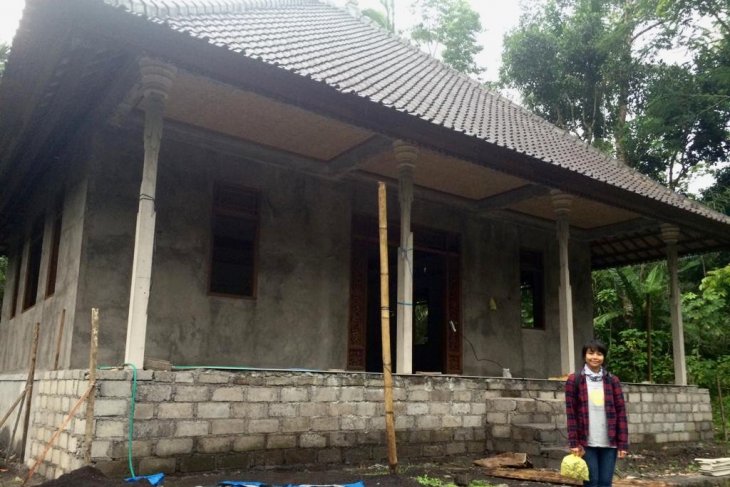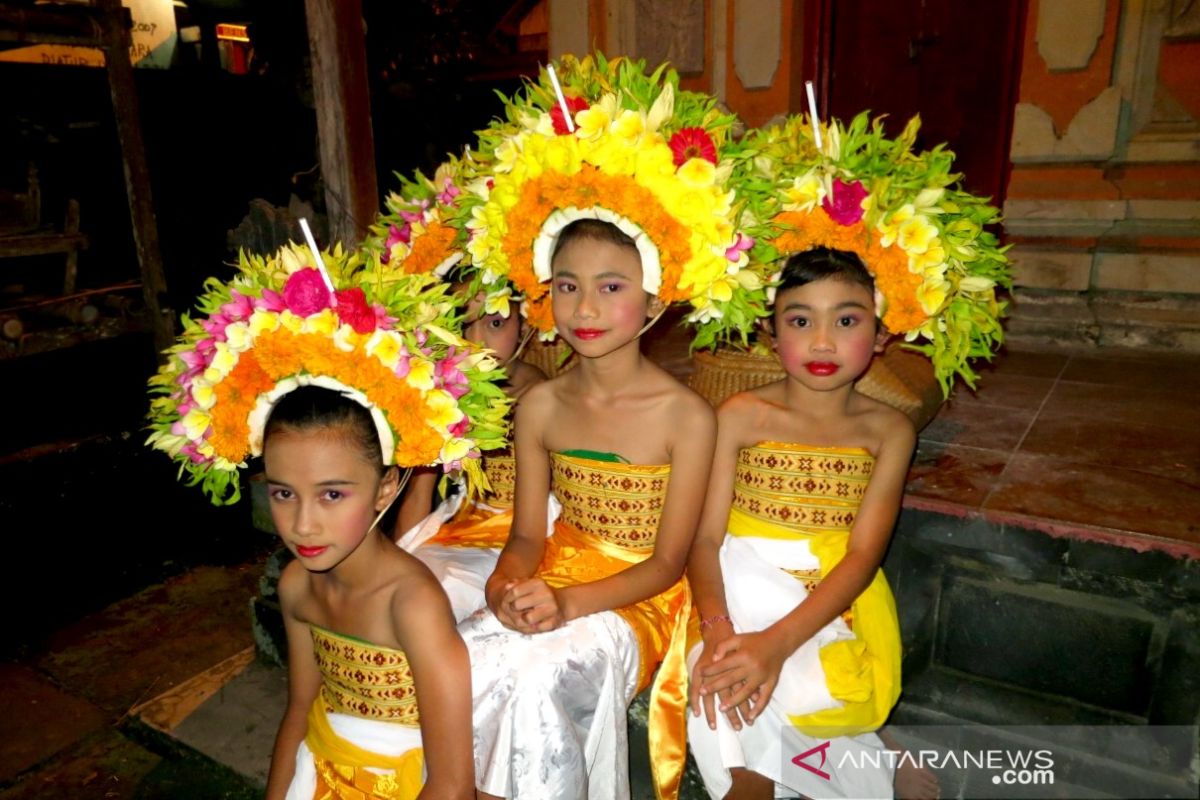In the middle of the priest’s prayer, the girls, in their white-golden colored traditional attire and flower headdress, fell unconscious. They were then moved from the temple to the Geriana Kauh Village’s main intersection where everyone sat in a circle while waiting for the girls to wake up from their trance and performed a sacred Sang Hyang Dedari dance. In Balinese, Dedari means the Goddesses, while Sang Hyang is the Revered and Divine One, the holiness.
Shortly thereafter, a choir of elderly women chanted in unison, the girls bent their bodies, stood right, but their eyes remained tightly closed. Some of them swung their yellow shawls to the right and left, while others climbed the three-meter-long bamboo tree to perform the dance.
For two to three hours, the girls, believed to be possessed by Goddesses, danced while making some unusual moves and footsteps. Their hand gestures, at a glance, bore resemblance to the outline of paddy. During the dance, the elderly women kept singing the poetic lyrics in a repetitive rhythm, while the men, in their all-white attire, watched over the girls while they climbed the bamboo tree.

“This dance is part of our gratitude to the Goddess of Fertility Dewi Sri, as she casts away pests, droughts, and all the bad luck ahead of the harvest season,” I Wayan Bhrata, former chief of the Geriana Kauh Village, who revived the tradition after a decade-long hiatus, stated.
Beyond performance
Why a dance instead of pesticides and fertilizers? Bhrata explained that although chemical-based pesticides and inorganic fertilizers might be effective in killing pests and securing the paddy until the harvest season, their impacts on the rice field ecosystem were dreadful.
“Eels, lindung (monitor lizards) were no longer seen in paddy fields. The soil then lost its fertility, as it was poisoned by chemicals from pesticides and fertilizers,” he stated.

“Beyond its aesthetic value, the dance lies at the core of the villagers’ green agricultural tradition that maintains harmonious relations between people and the environment,” Saraswati Putri, a young researcher who studied the dance for the past four years, stated.
Saraswati, a young Balinese assistant professor of the Philosophy Department, University of Indonesia, began her probe on the dance in 2014 along with few of her students. She traveled back and forth from Jakarta to Bali to seek testimonies from communities that yet practiced the Sang Hyang tradition that is considered to be extremely rare and hard to find.
Saraswati remarked that the villagers of Geriana Kauh in Karangasem District were part of the last community in Bali that yet performed the Sang Hyang Dedari dance, a primeval tradition claimed to date back before the Hindu tradition.
Sang Hyang Dedari was one of the few Sang Hyang traditions yet in practice today. Over 20 Sang Hyang dances flourished in Bali in the 1930s to 1980s. An anthropologist-cum-artist Jane Belo, in his book Trance in Bali, identified at least 20 Sang Hyang dances that not only involved young girls and the Goddesses but also men and women, who get possessed by snakes (Sang Hyang Lelipi), monkeys (Sang Hyang Bojog), horses (Sang Hyang Jaran), or even inanimate objects such as a broom (Sang Hyang Sampat), boat (Sang Hyang Prahu).
Most communities stopped performing the dances, as the paddy field made way for hotels, resorts, restaurants, and other tourist infrastructure. Saraswati expounded that the Sang Hyang Dedari dance was closely linked to the rice field, Bali’s irrigation system Subak, and the local rice seed Padi Mase (an ageless paddy).
A testimony of Balinese dance maestro Ni Ketut Arini revealed that Sang Hyang dance form once prevailed in Denpasar, though the community had stopped performing the ritual, as no rice field was left in Bali’s capital city,” Saraswati stated.
Community museum
In 2015, the UNESCO had acknowledged several dance forms of Bali, including the Sang Hyang Dedari, as part of the world’s intangible cultural heritage. However, Saraswati believes more acts must be organized in order to save the dance from extinction.
Hence, since 2015, Saraswati and a group of adolescents in Geriana Kauh, the village’s respected figures, the elderly men and women had worked on building a community museum of the Sang Hyang Dedari dance that will serve as a learning center and documentation for the Balinese old tradition.
“We hope our next generations would continue to perform the Sang Hyang Dedari dance. We do not want the dance to be forgotten and extinct,” Darpa, a respected figure, who also led the museum building project at Geriana Kauh Village, stated.

According to Saraswati, the museum will be operated by the village youngsters aged between 15 and 30 years.

Saraswati and the villagers had also planned to set up an ecotourism destination at Geriana Kauh, and the museum will serve as the main landmark.
“The basic principle of ecotourism is that no lives of people will be changed for the tourists. The rice field will not be transformed into hotels and resorts. The tourist will come to the village to learn about precious local geniuses and rich culture of Balinese’s old tradition and experience how the locals live here,” she stated.
The plan is currently underway. Saraswati remarked that the museum will become operational by the end of this year.
Related news: Sanur Village Festival 2019 opened by ministers Yahya, Puspayoga
Related news: Lakes Buyan, Tamblingan to be developed into ecotourism destinations
Related news: Foreign tourists partake in Galungan celebrations in Ubud
Editor: Sri Haryati
Copyright © ANTARA 2019












